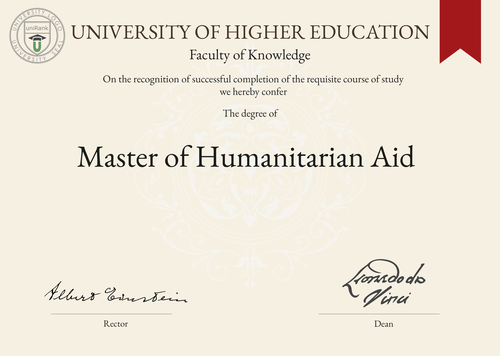
Master of Humanitarian Aid (MHA)
Guide to Master of Humanitarian Aid Program/Course/Degree
Master of Humanitarian Aid (MHA)

Program Name
Master of Humanitarian AidProgram or Degree abbreviation
MHADuration range
The duration of the Master of Humanitarian Aid program typically ranges from 1 to 2 years, depending on the university and country of study.Tuition range
The tuition fees for the Master of Humanitarian Aid program can vary significantly based on the chosen university and country of study. It is recommended to check with specific universities for accurate tuition information.Overview
The Master of Humanitarian Aid program is designed to provide students with a comprehensive understanding of humanitarian aid and disaster response. It equips students with the necessary skills and knowledge to effectively respond to humanitarian crises and contribute to the improvement of global humanitarian efforts.Curriculum Overview by year
The curriculum of the Master of Humanitarian Aid program is structured to cover various aspects of humanitarian aid. The following is a general overview of the curriculum by year: Year 1: - Introduction to Humanitarian Aid - Principles of Disaster Response - Humanitarian Law and Ethics - Project Management in Humanitarian Aid - Health and Nutrition in Emergencies Year 2: - Humanitarian Logistics and Supply Chain Management - Gender and Diversity in Humanitarian Aid - Advocacy and Policy in Humanitarian Aid - Research Methods in Humanitarian Aid - Fieldwork and Practical ExperienceKey Components
The key components of the Master of Humanitarian Aid program include: - Understanding the principles and frameworks of humanitarian aid - Developing skills in project management and logistics for effective aid delivery - Gaining knowledge of legal and ethical considerations in humanitarian contexts - Analyzing and addressing gender and diversity issues in humanitarian aid - Conducting research and fieldwork to enhance practical experienceCareer Prospects
Graduates of the Master of Humanitarian Aid program can pursue various career paths in the field of humanitarian aid. Potential career prospects include: - Humanitarian Aid Coordinator - Emergency Response Manager - Program Officer - Disaster Risk Reduction Specialist - Humanitarian Policy AnalystSalary Expectations
Salary expectations for professionals in the field of humanitarian aid can vary depending on factors such as experience, location and organization. It is important to note that salaries can range widely, from entry-level positions to senior management roles. For a more accurate understanding of salary expectations, you can utilize the Job Sites Search Engine, from our sister site jobRank, which searches over 4,600 job sites worldwide. Make sure to specify not only the job title but also the country you are interested in.Conclusions:
In conclusion, the Master of Humanitarian Aid program offers a comprehensive education in humanitarian aid and disaster response. It is important to consider that program duration, tuition fees, curriculum, key components, career prospects and salary expectations can vary based on the chosen country or location of study, as well as the university offering the program. Visitors interested in pursuing this degree can utilize the uniRank World Universities Search Engine to find institutions offering the Master of Humanitarian Aid program worldwide.World Universities Search Engine
search for Master of Humanitarian Aid (MHA) and add the Location (country, state etc.) or specific University you are interested in studying at.
Query examples:
- Master of Humanitarian Aid (MHA) United States
- Master of Humanitarian Aid (MHA) United Kingdom online
- Master of Humanitarian Aid (MHA) Australia international students
- Master of Humanitarian Aid (MHA) University of California
- Master of Humanitarian Aid (MHA) University of London tuition fees
- Master of Humanitarian Aid (MHA) University of Sydney scholarships
Share Program/Course
Interesting? Share this program/course/degree info with your friends now.